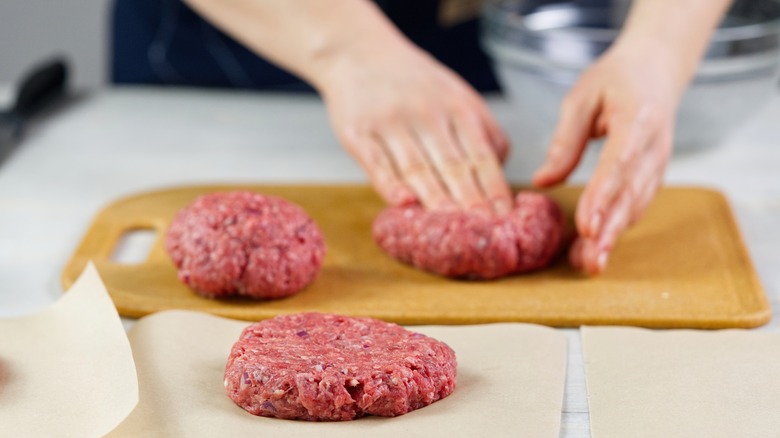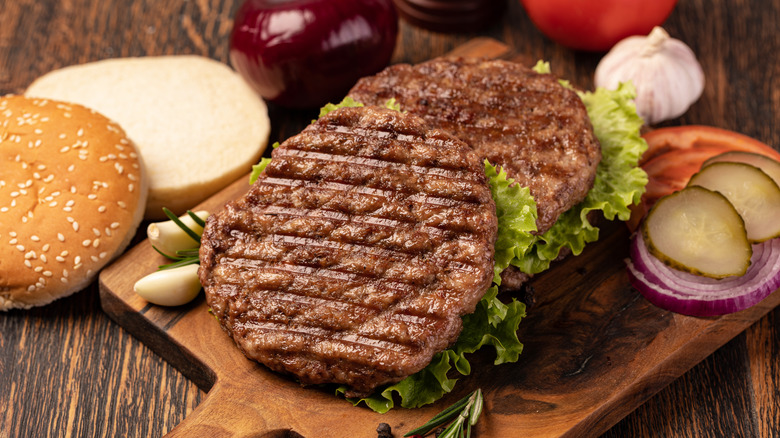How Rachael Ray Shapes Her Burgers To Prevent Shrinkage
Cooking homemade burgers is an immensely satisfying process that can result in a perfectly seared all-American cheeseburger housed in a soft, squishy bun. But, when you've spent time forming the meat into a shape that's just the right size, it's incredibly frustrating to see the patty begin to shrink on the grill. Luckily, Rachael Ray has a big tip to help prevent the shrinkage, and it involves making the burgers thinner in the middle than the edges.
The reason burgers shrink comes down to the proteins within the meat, which contract when heat is introduced. This causes it to lose moisture from the edges, while the center can look as though it's bulging. The solution, although tempting, is not to press the middle back down again with a spatula, which risks losing the precious juices into the pan or grill. Rather, focus on prevention over cure, which is exactly where Ray's trick comes in. It stops the problem before it even starts.
@rachaelray59 My burger patty tip for EVEN cooking Check out link in bio for more tips + tricks! RRatHOME TikTokRecipe cookingtips cooking burgertiptok created by Rachael Ray with Kenyis Up Beat (Married Life)
By shaping a patty that's slimmer in the center, it means that the indentation can fill as the meat is heated, so it ends up with the same thickness as the edges. The result is a burger that cooks more evenly throughout, without the risk of being overcooked around the outside with an underdone middle, and of course without the shrinkage. As an added bonus, it's also easier to add toppings thanks to its flatter surface.
Rachael Ray's technique relies on a light touch
When it comes to the best way to make burger patties, it's important to make them of an equal size if you're cooking a batch, and within a similar time-frame, so that all the burgers cook uniformly. Rachael Ray likes to put all the meat in one mound first, and then scores it so she can evenly divide everything into similar-sized portions. Then, rather than using any special gadgets to shape the patties to avoid shrinkage, Ray does so by hand.
Unlike the popular thumbprint trick, which involves using your thumb to make a smaller but deeper indentation in the middle of the meat, Ray simply forms the patties slightly thicker around the edges by rotating the discs and flattening the centers. This prevents what she calls "flying saucer patties" (via Facebook) which shrink in size, but seem to inflate in the middle during the cooking process.
However, don't spend too much time forming the patties by hand. If they're overworked, the meat becomes too tightly packed and can end up becoming dry and tough, which, let's face it, is just as disappointing as the burgers shrinking. Work quickly and with a light touch to keep the mix more loosely packed, and you'll be rewarded with a burger that stays deliciously juicy once cooked.
More tips for making perfect patties to avoid shrinkage
While it's important to make an indent in the patty to help prevent shrinkage and the dreaded bulge, there's no getting around the fact that meat can shrink when cooked. To avoid serving a patty that's too small for the bread, shape it slightly larger than the circumference of the bun to start with. Also, a blend of meat that's 80% lean and 20% fat will help maintain the shape, and keep it juicy, too.
Another tip: Season your meat at the last minute before cooking, as salting too far in advance can cause the meat to dry out. And, keep things simple; Bobby Flay only uses two ingredients to season his burgers: salt and pepper. To make sure the taste is well-balanced before you cook a whole batch, Rachael Ray's tip to get burger seasoning exactly right is to make a small patty about the size of a quarter that you can test first before whipping up a burger feast.
Just as you don't want to handle raw patties too much, you also don't need to fuss over them once they're cooking. Don't be tempted to keep flipping, and definitely don't press down on them with the back of a spatula, even if they do seem to shrink. It's better to have a slightly smaller piece of meat than one that has lost its succulence.



